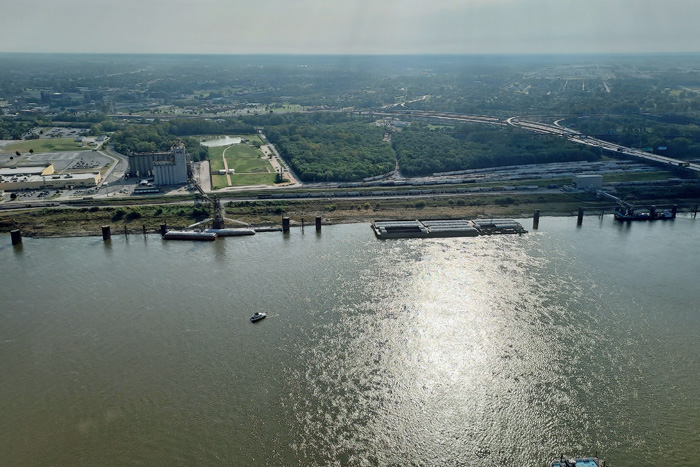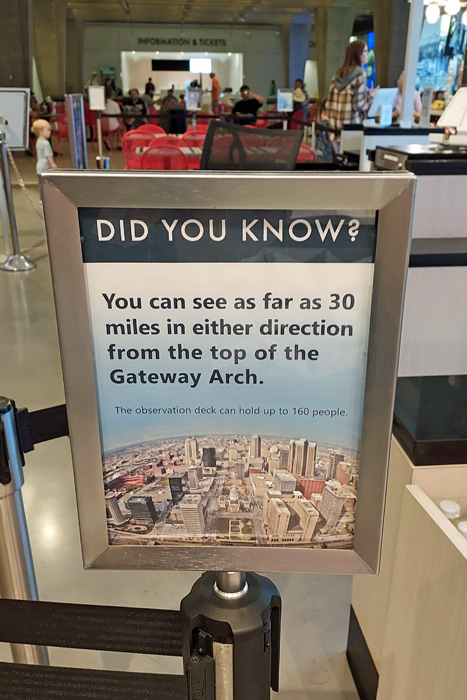The Gateway Arch in St. Louis is 630 feet tall (or 192 meters), while the Palais Royale in Mumbai is 1,050 feet tall
(or 320 meters).
How much farther can a person at the top of Palais Royale see than a person at the top of the Gateway Arch?
You may use 4,000 miles as the radius of the Earth.
Here are some photos that I took when I visited the Gateway Arch last Fall:

View from the top of the arch (you can see the shadow of the arch in the picture)

View of the Mississippi River from the top of the arch

Inside the Keystone at the top of the arch

A sign in the cafeteria, but your answer must be more precise!
Solution to the Problem:
A person at the top of Palais Royale can see 8.991 miles (14,470 meters) farther than a person at the top of Gateway Arch.In the diagram below, h represents the height of the building, R is the radius of the earth, and OG is the distance that can be seen from the top of the building.

OG is a tangent line to the earth and we know that it forms a right angle with the radius, so triangle OCG is a right triangle.
Convert distances to the same units and apply the Pythagorean Theorem.
I chose to convert to miles. 1,050 feet is equivalent to .19886 miles and 630 feet is equal to .1193 miles.
So, for the Palais Royale: (4,000.19886)2 = (4,000)2 + (OG)2
and, for the Gateway Arch: (4,000.1193)2 = (4,000)2 + (OG)2
Solving for OG:
for the Palais Royale, OG = 39.887 miles
for the Gateway Arch, OG = 30.896 miles
Therefore, the difference is 39.887 - 30.896 = 8.991 miles.
So the sign in the Gateway Arch was correct, since the line of sight would be slightly lower than the top of the arch and therefore the distance would be slightly less than 30.896 miles.
Seth Cohen used trigonometry to solve the problem:
Let your height above the Earth's surface be h, and Earth's radius be r.
Draw a line from Earth's center (call this C) to h. From h, draw a line tangent to the surface, which represents your farthest line of sight.
Where this line touches the surface, call this P.
Draw another line from P to C.
We now have a right triangle made of these lines.
The right angle is at P, because it's made of a radius and a tangent line.
First, find the angle made by CP and Ch, denoted a.
cos(a) = r/(r+h)
a = arccos(r/(r+h))
Now, the distance along the surface of the Earth that corresponds to this angle is r*a, or r*arccos(r/(r+h)).
Plug in numbers:
Gateway:
630 ft = 0.119318 miles
4000*arccos(4000/4000.119318) = 30.895 miles
Palais:
1050 ft = 0.1988636 miles
4000*arccos(4000/4000.1988636) = 39.885 miles
You can see about 9 miles farther from Palais.
Correctly solved by:
| 1. K. Sengupta | Calcutta, India |
| 2. Kamal Lohia |
Holy Angel School, Hisar, Haryana, India |
| 3. Seth Cohen | Concord, New Hampshire, USA |
| 4. Kelly Stubblefield | Mobile, Alabama, USA |
| 5. Colin (Yowie) Bowey | Beechworth, Victoria, Australia |